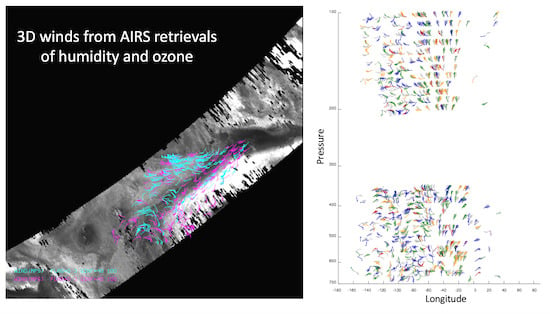Demonstration and Evaluation of 3D Winds Generated by Tracking Features in Moisture and Ozone Fields Derived from AIRS Sounding Retrievals
Abstract
:1. Introduction
2. Materials and Methods
2.1. Retrievals of Temperature, Humidity, and Ozone
2.2. AIRS Image Processing
2.3. Derivation of 3D AMVs
2.4. Data Assimilation and Forecast Model
- GSI analysis at ~½° resolution with 72 vertical levels
- 3DVar
- 6-h assimilation cycle
- 7-day forecasts, adjoint-based 24-h observations
- Impacts at 0000 UTC (dry energy norm, sfc-150 hPa)
- Observation error is 9 ms−1 for AIRS winds
- Control: The Control run contained all of the standard data sources, including the MODIS IR and WV AMVs.
- Exp. 1 (AIRS AMVs): Exp. 1 was run identically to the control, with the addition of the AIRS moisture and ozone AMVs. This allowed the incremental impact due to the addition of AIRS winds to be highlighted, as all other data sources remained constant.
- Exp. 2 (ex2): Exp. 2 was run identically to Exp. 1, with the removal of the MODIS WV winds. The experiment replaces the MODIS WV winds with the AIRS WV winds, which were in similar clear sky regions, testing the usage of sounder winds instead of AMVs from the water vapor channel on MODIS. This is important as the Terra MODIS WV winds were turned off in mid-2013 due to a degraded band 27 channel. Also, VIIRS on S-NPP and the JPSS series do not have a water vapor channel, which may be compensated by using sounder AMVs from CrIS.
- Exp. 3 (ex3): Exp. 3 was run identically to Exp. 1, however with all MODIS winds removed. This tests the impact of AIRS winds (only from Aqua) as a complete replacement of MODIS winds (from Aqua and Terra).
3. Results
3.1. Comparison of AIRS AMVs to MODIS AMVs
3.2. Evaluation of AIRS AMVs in the GEOS-5
3.2.1. Assimilation Impact
3.2.2. Forecast Impact
- Although not statistically significant, the addition of the AIRS AMVs (red) shows a slight improvement in the ACC score after Day 4 (Figure 13b).
- The removal of the MODIS AMVs (blue) shows a decrease in the ACC score, as the AIRS AMVs are unable to offset the loss of the MODIS AMVs, indicating that the AIRS AMVs complement the MODIS AMVs and should not be considered a replacement. This was expected as the AIRS AMVs are in clear sky or above cloud regions, while the MODIS AMVs include cloud-tracked features.
3.3. Continuing Evaluation of the AIRS AMVs
…the ob impact stats looked OK and they are comparable to other polar winds in impact per ob. The innovation statistics were also similar to other polar winds. The problem is that there just aren’t enough of them to make much of an impact.
4. Discussion
5. Conclusions
- The AIRS AMVs compare favorably to co-located MODIS AMVs for a six-week period, as evidenced by a zero-speed bias with a standard deviation of 3.5 ms−1.
- The impact per AIRS moisture AMV is very good, as they are ranked higher than all other satellite-derived wind datasets.
- The neutral, or slightly positive, forecast impact due to the addition of the AIRS retrieval AMVs is encouraging as these AMVs are only in the polar region, but they have an impact in the longer-range forecast over the northern hemisphere.
Author Contributions
Funding
Acknowledgments
Conflicts of Interest
References
- Breitman, K. Failure to Prepare for Extreme Weather Costs Billions. USA Today. 2014. Available online: http://www.usatoday.com/story/news/nation/2014/02/12/costs-unpreparedness-critical-weatherevents/5417257/ (accessed on 1 July 2019).
- Gentry, B.; Atlas, R.; Baker, W.; Emmitt, G.D.; Hardesty, R.M.; Kakar, R.; Kavaya, M.; Mango, S.; Miller, K.; Riishojgaard, L.P. Recent US Activities Toward Development of a Global Tropospheric 3D Wind Profiling System. In Proceedings of the American Geophysical Union Fall Meeting, San Francisco, CA, USA, 15–19 December 2008. [Google Scholar]
- Dessler, A.E.; Palm, S.P.; Spinhirne, J.D. Tropical cloud-top height distributions revealed by the Ice, Cloud, and Land Elevation Satellite (ICESat)/Geoscience Laser Altimeter System (GLAS). J. Geophys. Res. 2006, 111, D12215. [Google Scholar] [CrossRef]
- A Community Assessment and Strategy for the Future, Earth Science and Applications from Space. National Imperatives for the Next Decade and Beyond; National Research Council: Washington, DC, USA, 2007; ISBN 0-309-66714-3.
- Zeng, X.; Ackerman, S.; Ferraro, R.D.; Murray, J.J.; Pawson, S.; Reynolds, C.; Teixeira, J. Workshop Report on Scientific Challenges and Opportunities in the NASA Weather Focus Area; NASA: Washington, DC, USA, 2015.
- Keyser, D. On the representation and diagnosis of frontal circulations in two and three dimensions. In The Life Cycles of Extratropical Cyclones; Shapiro, M.A., Gronas, S., Eds.; American Meteorological Society: Boston, MA, USA, 1999; pp. 239–264. [Google Scholar]
- Pu, B.; Cook, K.H. Dynamics of the West African Westerly Jet. J. Clim. 2010, 23, 6263–6276. [Google Scholar] [CrossRef]
- Baker, W.E.; Atlas, R.; Cardinali, C.; Clement, A.; Emmitt, G.D.; Gentry, B.M.; Hardesty, R.M.; Källén, E.; Kavaya, M.J.; Langland, R.; et al. Lidar-Measured Wind Profiles: The Missing Link in the Global Observing System. Bull. Am. Meteorol. Soc. 2014, 95, 543–564. [Google Scholar] [CrossRef]
- Charron, M.; Polavarapu, S.; Buehner, M.; Vaillancourt, P.A.; Charette, C.; Roch, M.; Morneau, J.; Garand, L.; Aparicio, J.M.; MacPherson, S.; et al. The Stratospheric extension of the Canadian global deterministic medium-range weather forecasting system and its impact on tropospheric forecasts. Mon. Weather. Rev. 2012, 140, 1924–1944. [Google Scholar] [CrossRef]
- Kidston, J.; Scaife, A.; Hardiman, S.; Mitchell, D.; Butchart, N.; Baldwin, M.; Gray, L. Stratospheric influence on tropospheric jet streams, storm tracks and surface weather. Nat. Geosci. 2015, 8, 433–440. [Google Scholar] [CrossRef]
- Menzel, W.P. Cloud tracking with satellite imagery: From the pioneering work of Ted Fujita to the present. Bull. Am. Meteorol. Soc. 2001, 82, 33–47. [Google Scholar] [CrossRef]
- Key, J.R.; Santek, D.; Velden, C.S.; Bormann, N.; Thépaut, J.-N.; Riishojgaard, L.P.; Zhu, Y.; Menzel, W.P. Cloud-Drift and Water Vapor Winds in the Polar Regions from MODIS. IEEE Trans. Geosci. Remote Sens. 2003, 41, 482–492. [Google Scholar] [CrossRef]
- Santek, D. The Global Impact of Satellite-Derived Polar Winds on Model Forecasts. Ph.D. Thesis, University of Wisconsin-Madison, Madison, WI, USA, 2007. [Google Scholar]
- Susskind, J.; Barnet, C.D.; Blaisdell, J.M. Retrieval of atmospheric and surface parameters from AIRS/AMSU/HSB data in the presence of clouds. IEEE Trans. Geosci. Remote Sens. 2003, 42, 390–409. [Google Scholar] [CrossRef]
- Goldberg, M.D.; Qu, Y.; McMillin, L.M.; Wolf, W.; Zhou, L.; Divakarla, M. AIRS near-real-time products and algorithms in support of operational numerical weather prediction. IEEE Trans. Geosci. Remote Sens. 2003, 41, 379–389. [Google Scholar] [CrossRef]
- Weisz, E.; Li, J.; Menzel, W.P.; Heidinger, A.K.; Kahn, B.H.; Liu, C.-Y. Comparison of AIRS, MODIS CloudSat and CALIPSO cloud top height retrievals. Geophys. Res. Lett. 2007, 34, L17811. [Google Scholar] [CrossRef]
- Weisz, E.; Smith, W.L.; Li, J.; Menzel, W.P.; Smith, N. Improved Profile and Cloud Top Height Retrieval by Using Dual-regression on High-Spectral Resolution Measurements. In Proceedings of the Hyperspectral Imaging and Sounding of the Environment (HISE), Toronto, ON, Canada, 10–14 July 2011; OSA Technical Digest Series (CD) Optical Society of America: Washington, DC, USA, 2011. [Google Scholar]
- Weisz, E.; Smith, W.L.; Smith, N. Advances in simultaneous atmospheric profile and cloud parameter regression-based retrieval from high-spectral resolution radiance measurements. J. Geophys. Res. Atmos. 2013, 118, 6433–6443. [Google Scholar] [CrossRef]
- Smith, W.L.; Weisz, E.; Kirev, S.; Zhou, D.K.; Li, Z.; Borbas, E.E. Dual-Regression Retrieval Algorithm for Real-Time Processing of Satellite Ultraspectral Radiances. J. Appl. Meteorol. Clim. 2012, 51, 1455–1476. [Google Scholar] [CrossRef]
- Hautecoeur, O.; Héas, P.; Borde, R. Extraction of 3D wind profiles from IASI level 2 products. In Proceedings of the Thirteenth International Winds Workshop, Monterey, CA, USA, 27 June–1 July 2016. [Google Scholar]
- Holmlund, K. The utilization of statistical properties of satellite−derived atmospheric motion vectors to derive quality indicators. Weather Forecast. 1998, 12, 1093–1103. [Google Scholar] [CrossRef]
- Hayden, C.; Pursor, R.J. Recursive filter objective analysis of meteorological fields: Applications to NESDIS operational processing. J. Appl. Meteorol. 1995, 34, 3–15. [Google Scholar] [CrossRef]
- Rienecker, M.M.; Suarez, M.J.; Todling, R.; Bacmeister, J.; Takacs, L.; Liu, H.-C.; Gu, W.; Sienkiewicz, M.; Koster, R.D.; Gelaro, R.; et al. The GEOS-5 Data Assimilation System—Documentation of Versions 5.0.1, 5.1.0, and 5.2.0; Technical Report Series on Global Modeling and Data Assimilation; NASA/GSFC: Greenbelt, MD, USA, 2008; p. 27.
- McCarty, Will (NASA/GMAO), 2015, e-mail message to author, October 15.
- Pauley, Randy (FNMOC), 2015, e-mail message to author, September 15.
- Santek, D. The Impact of Satellite-Derived Polar Winds on Lower-Latitude Forecasts. Mon. Weather Rev. 2010, 138, 123–139. [Google Scholar] [CrossRef]
- GEOS Systems. Available online: https://gmao.gsfc.nasa.gov/GEOS/ (accessed on 29 October 2019).


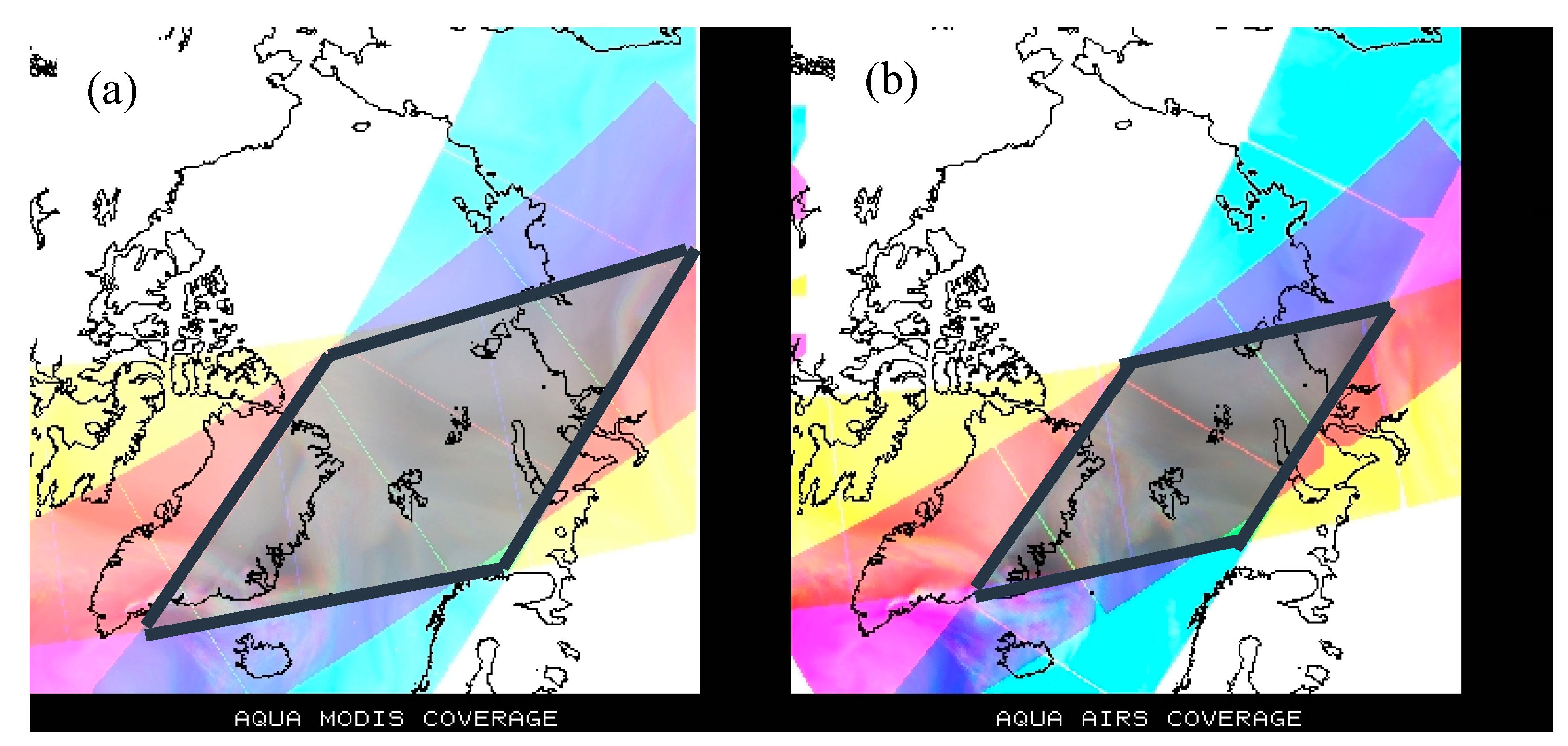
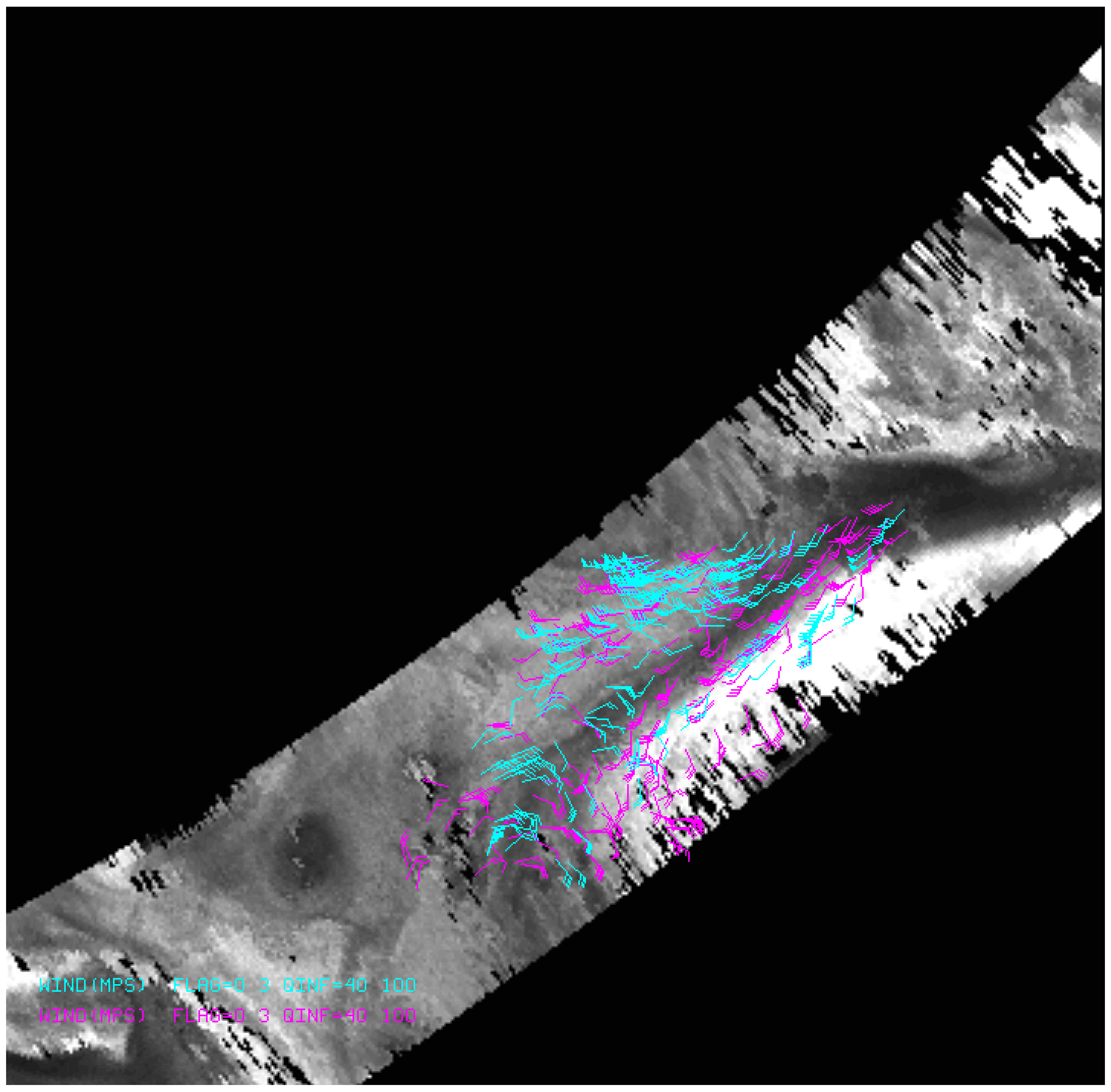
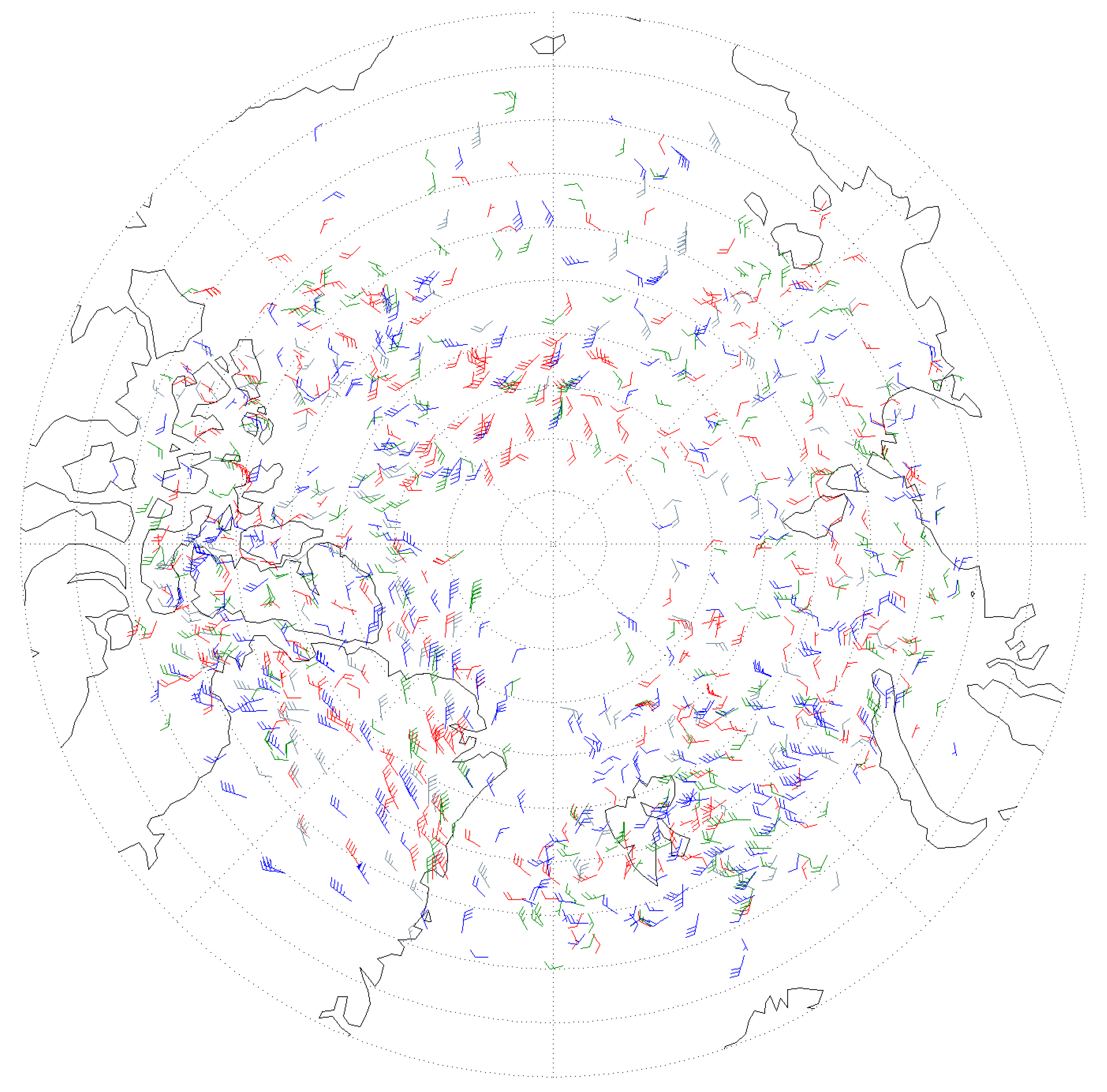




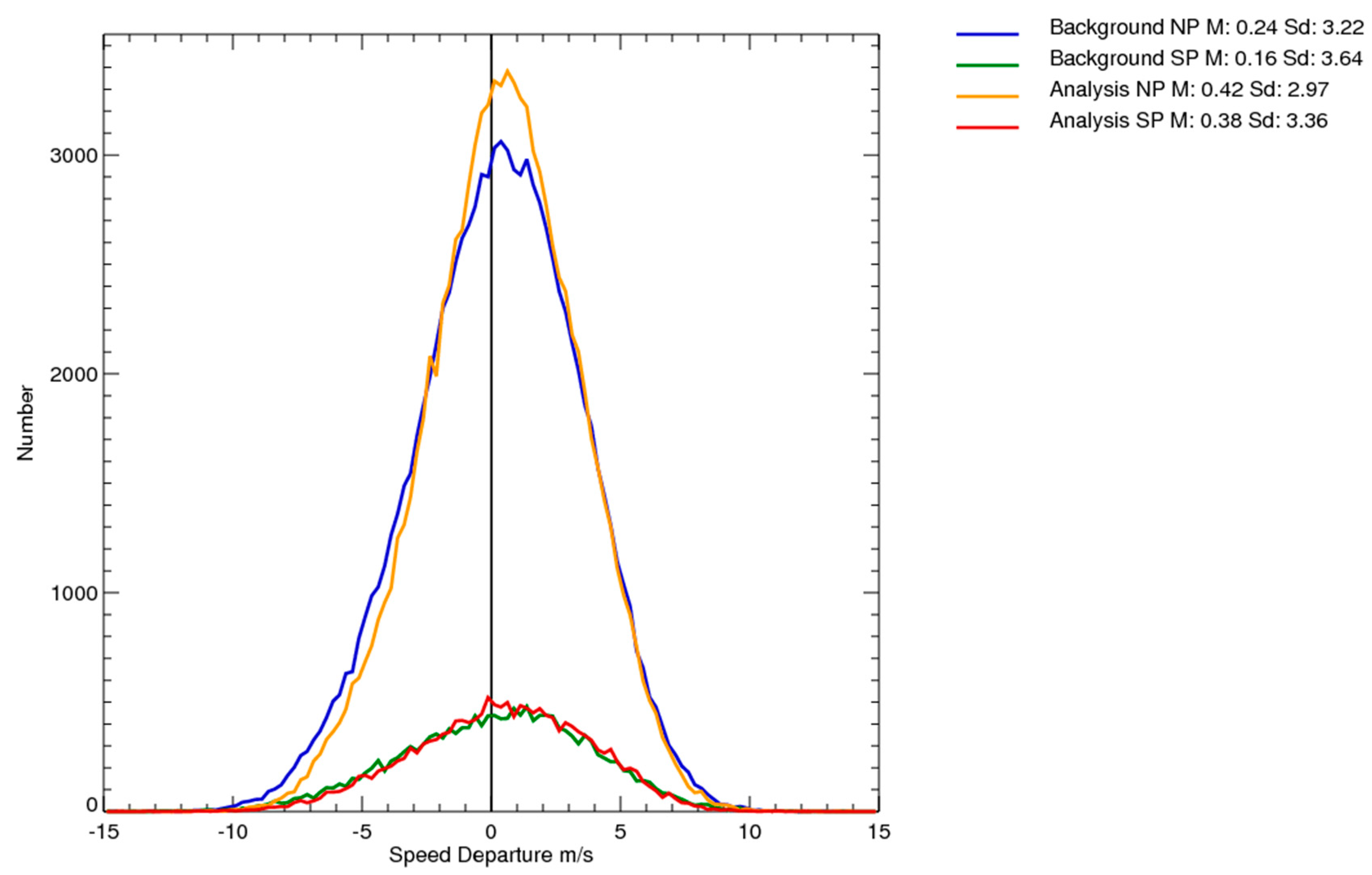


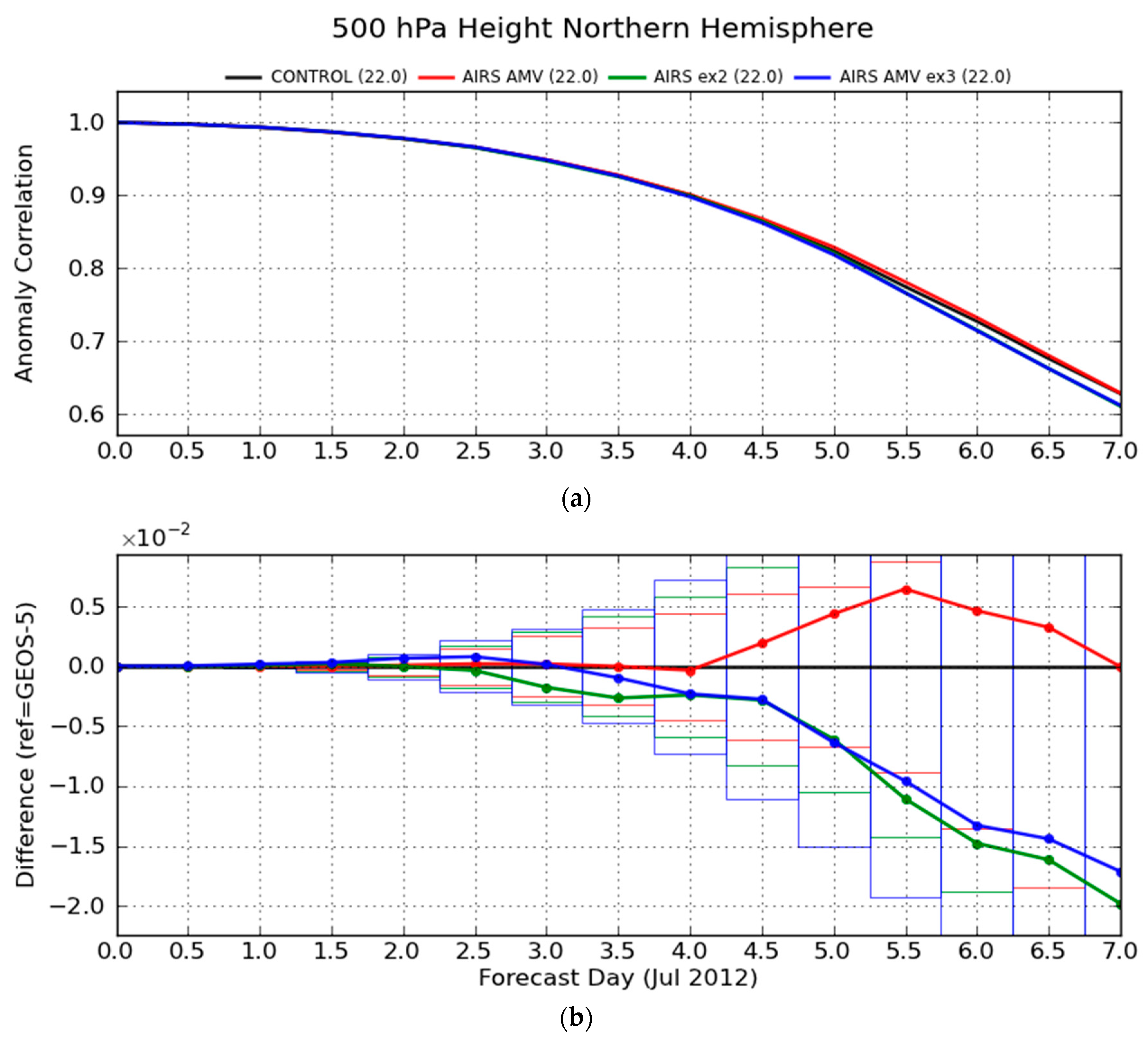

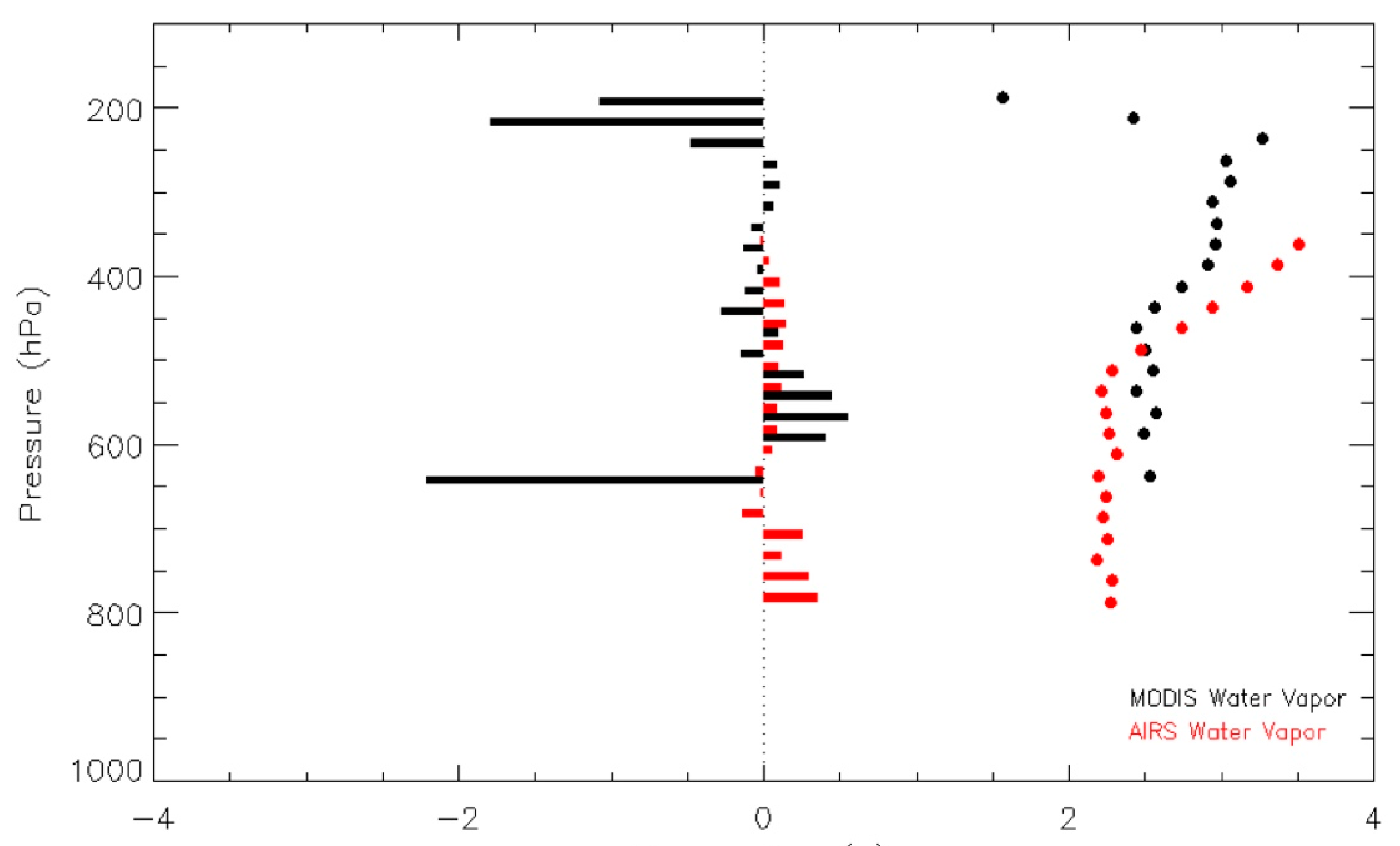

© 2019 by the authors. Licensee MDPI, Basel, Switzerland. This article is an open access article distributed under the terms and conditions of the Creative Commons Attribution (CC BY) license (http://creativecommons.org/licenses/by/4.0/).
Share and Cite
Santek, D.; Nebuda, S.; Stettner, D. Demonstration and Evaluation of 3D Winds Generated by Tracking Features in Moisture and Ozone Fields Derived from AIRS Sounding Retrievals. Remote Sens. 2019, 11, 2597. https://doi.org/10.3390/rs11222597
Santek D, Nebuda S, Stettner D. Demonstration and Evaluation of 3D Winds Generated by Tracking Features in Moisture and Ozone Fields Derived from AIRS Sounding Retrievals. Remote Sensing. 2019; 11(22):2597. https://doi.org/10.3390/rs11222597
Chicago/Turabian StyleSantek, David, Sharon Nebuda, and Dave Stettner. 2019. "Demonstration and Evaluation of 3D Winds Generated by Tracking Features in Moisture and Ozone Fields Derived from AIRS Sounding Retrievals" Remote Sensing 11, no. 22: 2597. https://doi.org/10.3390/rs11222597



